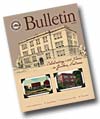
About this issue:
Setting the pace for century of growth
Last summer, when the second and third floors of the Administration
Building were once againrenovated for new space and technology
needs, the tall, dark wooden doors that opened or closed the wings
of the former Assembly Hall were uncovered by Physical Plant personnel
who were preparing to reframe a southwest classroom. With other
Public Relations staff members, I looked up photos of the space
now known as “Ad 29” and realized, not for the first
time, that this nearly 100-year-old building has accommodated
one of the most revolutionary centuries for human progress –
from plumbing, heating and electricity to telephone, cable and
Internet wiring – as well as the industrious spirit of faculty
and students expanding hearts and minds in the spirit of “Culture
for Service.”
In the year that ground was broken among wheat stalks, not maple
trees, for the Goshen College Administration Building, Theodore
Roosevelt was president of the United States (which was populated
by 76 million people living in 48 states); Marie Curie won the
Nobel Prize in physics; the Wright brothers flew the world’s
first successful airplane; the first baseball World Series was
played; India suffered a devastating plague; and the several thousand
residents of the City of Goshen got a new neighbor.
That first remarkable year of our campus in Goshen, 1903-1904,
perhaps set the particular pace and energy for vision, leadership,
innovation, service, creativity, school spirit and growth that
has characterized Goshen College through successive generations.
On a tour of Goshen College today – whether in a multimedia
experience (see our new online “Virtual GC” feature
at www.goshen.edu/virtualgc
to see the campus today) or physical tour of campus – one
can glimpse a century of goals made and reached: 18 major buildings
surrounded by a campus park of 135 acres where maples stretch
high and Frisbee players have green grass on which to play in
all seasons. Additions and renovations have created spaces –
from new residence halls to science labs, parking lots to multimedia
classrooms, performance halls to small group housing – suited
to the times and to the needs of students and faculty. A phone
system serves every room, and Internet connections reach every
building. Today, I can correspond via e mail with alumni from
Goshen or Germany, parents from Pennsylvania or Paraguay or SST
leaders in Cuba or China.
Yet our facilities and grounds and technology reveal only a fraction
of the results of GC productivity sparked by the life of mind
and spirit of individuals gathered in an intentional community
of faith and learning. On this campus, church leaders have been
called; new chemical compounds have been created; hymns have been
composed; books have been written; plays have had their debut;
postcards have arrived from around the world; and a very special
community continues to generate: its unique traditions and tales:
when we gathered on the steps of Kulp Hall to kick off renovations
to our oldest standing residential building, it was not blueprints
that we reviewed, but stories were shared about very early campus
pranks (a midnight visit to slumbering female students by confused
sheep placed there by a group of males) to courting Kulp style.
This institution has attracted, since its beginnings, individuals
who wish to use their gifts not only to further their own studies
but also to contribute positively to their campus, church and
world. In furthering their knowledge, 19,500 alumni have made
this campus an inspiring axis of questions and ideas; in deepening
their discipleship, they have continued into lives of service
and leadership. Participation and accountability is important
here, exampled by faculty and students across time. The spirit
that drives Goshen College today was perhaps seeded when a wheat
field was cleared 100 years ago.

 About this issue:
About this issue: 

